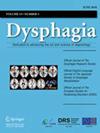Ryan J Burdick, Nicole Rogus-Pulia, Rebecca Schwei, Sara Gustafson, Raele Donetha Robison, Rosemary Martino, Michael Pulia
求助PDF
{"title":"Accuracy of Dysphagia Screening by Non-clinical Research Staff in the Emergency Department.","authors":"Ryan J Burdick, Nicole Rogus-Pulia, Rebecca Schwei, Sara Gustafson, Raele Donetha Robison, Rosemary Martino, Michael Pulia","doi":"10.1007/s00455-024-10710-5","DOIUrl":null,"url":null,"abstract":"<p><p>Although the emergency department (ED) is the initial care setting for the majority of older adults requiring hospital admission, there is a paucity of ED-based dysphagia research in this at-risk population. This is driven by barriers to dysphagia evaluation in this complex care environment. Therefore, we assessed the reliability of trained, non-clinical ED research staff in administering dysphagia screening tools compared to trained speech pathologists (SLPs). We also aimed to determine perceptual screening discrepancies (e.g. voice change) between clinical and non-clinical staff. Forty-two older adults with suspected pneumonia were recruited during an ED visit and underwent dysphagia (Toronto Bedside Swallow Screening Tool; TOR-BSST©) and aspiration (3-oz water swallow test; 3-oz WST) screening by trained non-clinical research staff. Audio-recordings of screenings were re-rated post-hoc by trained, blinded SLPs with discrepancies resolved via consensus. Cohen's kappa (unweighted) revealed moderate agreement in pass/fail ratings between clinical and non-clinical staff for both the TOR-BSST© (k = 0.75) and the 3 oz WST (k = 0.66) corresponding to excellent sensitivity and good specificity for both the TOR-BSST (SN = 94%, SP = 85%) and the 3 oz WST (SN = 90%, SP = 81%). Further analysis of TOR-BSST perceptual parameters revealed that most discrepancies between clinicians and non-clinicians resulted from over-diagnosis of change in vocal quality (53%). These results support the feasibility of non-clinical research staff administering screening tools for dysphagia and aspiration in the ED. Dysphagia screening may not necessitate clinical staff involvement, which may improve feasibility of large-scale ED research. Future training of research staff should focus on perceptual assessment of vocal quality.</p>","PeriodicalId":11508,"journal":{"name":"Dysphagia","volume":" ","pages":"132-140"},"PeriodicalIF":2.2000,"publicationDate":"2025-02-01","publicationTypes":"Journal Article","fieldsOfStudy":null,"isOpenAccess":false,"openAccessPdf":"","citationCount":"0","resultStr":null,"platform":"Semanticscholar","paperid":null,"PeriodicalName":"Dysphagia","FirstCategoryId":"3","ListUrlMain":"https://doi.org/10.1007/s00455-024-10710-5","RegionNum":3,"RegionCategory":"医学","ArticlePicture":[],"TitleCN":null,"AbstractTextCN":null,"PMCID":null,"EPubDate":"2024/5/30 0:00:00","PubModel":"Epub","JCR":"Q1","JCRName":"OTORHINOLARYNGOLOGY","Score":null,"Total":0}
引用次数: 0
引用
批量引用
Abstract
Although the emergency department (ED) is the initial care setting for the majority of older adults requiring hospital admission, there is a paucity of ED-based dysphagia research in this at-risk population. This is driven by barriers to dysphagia evaluation in this complex care environment. Therefore, we assessed the reliability of trained, non-clinical ED research staff in administering dysphagia screening tools compared to trained speech pathologists (SLPs). We also aimed to determine perceptual screening discrepancies (e.g. voice change) between clinical and non-clinical staff. Forty-two older adults with suspected pneumonia were recruited during an ED visit and underwent dysphagia (Toronto Bedside Swallow Screening Tool; TOR-BSST©) and aspiration (3-oz water swallow test; 3-oz WST) screening by trained non-clinical research staff. Audio-recordings of screenings were re-rated post-hoc by trained, blinded SLPs with discrepancies resolved via consensus. Cohen's kappa (unweighted) revealed moderate agreement in pass/fail ratings between clinical and non-clinical staff for both the TOR-BSST© (k = 0.75) and the 3 oz WST (k = 0.66) corresponding to excellent sensitivity and good specificity for both the TOR-BSST (SN = 94%, SP = 85%) and the 3 oz WST (SN = 90%, SP = 81%). Further analysis of TOR-BSST perceptual parameters revealed that most discrepancies between clinicians and non-clinicians resulted from over-diagnosis of change in vocal quality (53%). These results support the feasibility of non-clinical research staff administering screening tools for dysphagia and aspiration in the ED. Dysphagia screening may not necessitate clinical staff involvement, which may improve feasibility of large-scale ED research. Future training of research staff should focus on perceptual assessment of vocal quality.
急诊科非临床研究人员进行吞咽困难筛查的准确性。
尽管急诊科(ED)是大多数需要入院治疗的老年人的初始治疗场所,但针对这一高风险人群的基于急诊科的吞咽困难研究却很少。这是因为在这种复杂的护理环境中进行吞咽困难评估存在障碍。因此,我们评估了受过训练的非临床 ED 研究人员与受过训练的语言病理学家 (SLP) 相比,在使用吞咽困难筛查工具时的可靠性。我们还旨在确定临床和非临床工作人员之间的感知筛查差异(如变声)。我们在急诊室就诊时招募了 42 名疑似肺炎的老年人,由经过培训的非临床研究人员进行吞咽困难(多伦多床边吞咽筛查工具;TOR-BSST©)和吸入(3 盎司水吞咽试验;3 盎司 WST)筛查。筛查录音由经过培训的盲人辅助语言治疗师进行事后重新评分,不一致之处通过协商一致的方式解决。Cohen's kappa(未加权)显示,临床和非临床工作人员对 TOR-BSST© (k = 0.75)和 3 盎司 WST(k = 0.66)的通过/未通过评级的一致性适中,相应地,TOR-BST(SN = 94%,SP = 85%)和 3 盎司 WST(SN = 90%,SP = 81%)的灵敏度极高,特异性良好。对 TOR-BSST 感知参数的进一步分析表明,临床医生和非临床医生之间的大多数差异都是由于对声乐质量变化的过度诊断造成的(53%)。这些结果支持非临床研究人员在急诊室使用吞咽困难和吸入障碍筛查工具的可行性。吞咽困难筛查可能不需要临床人员的参与,这可能会提高大规模急诊室研究的可行性。今后对研究人员的培训应侧重于对发声质量的感知评估。
本文章由计算机程序翻译,如有差异,请以英文原文为准。


 求助内容:
求助内容: 应助结果提醒方式:
应助结果提醒方式:


